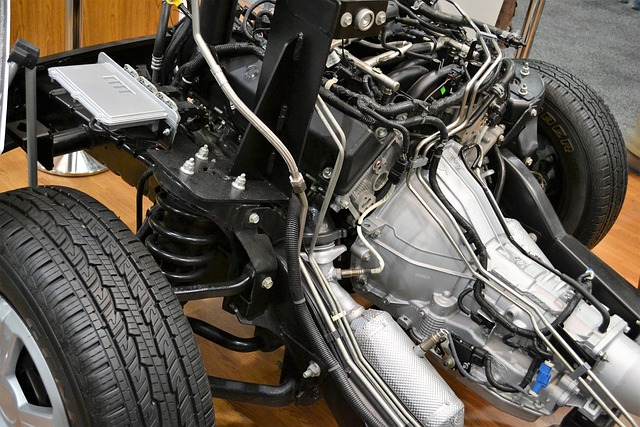The automotive industry is shifting from steel to aluminum as the primary material for vehicle manufacturing, driven by its superior strength-to-weight ratio and environmental benefits. This transition enables more innovative designs and promotes sustainability goals by reducing fuel consumption. As demand grows for lightweight and eco-friendly vehicles, specialized repairs like paintless dent repair will become more common. Carbon fiber components are also poised to play a role, offering advanced properties of strength, lightness, and cost-effectiveness. Aluminum body components revolutionize cars with enhanced corrosion resistance, durability, and intricate designs, while carbon fiber stands out for its unique benefits but different applications. This evolution demands strategic adjustments in vehicle design and construction, influencing auto repair methods that require specialized techniques to address lighter materials without compromising structural stability.
Aluminum body components are revolutionizing the automotive industry, driving the future of auto repairs towards lighter, stronger, and more sustainable vehicles. As manufacturers embrace the benefits of aluminum over traditional materials, we see a shift towards improved fuel efficiency and performance. This article delves into the rise of aluminum, comparing it with carbon fiber components, and explores how these advanced materials are shaping the future of automotive repair processes. With sustainability at the forefront, we predict trends that combine innovative technologies and eco-friendly practices in vehicle maintenance.
- The Rise of Aluminum in Automotive Manufacturing
- – Exploring the benefits and advantages of aluminum body components over traditional materials.
- – Discussing the shift towards lighter vehicles for improved fuel efficiency and performance.
The Rise of Aluminum in Automotive Manufacturing

The automotive industry is witnessing a significant shift towards aluminum as a primary material for vehicle manufacturing, marking a substantial departure from traditional steel. This trend is driven by several key factors. Aluminum offers an exceptional strength-to-weight ratio, making it lighter and more fuel-efficient than its steel counterpart. In an era where sustainability and reducing carbon emissions are paramount, this advantage cannot be overlooked. The use of aluminum also facilitates innovative design possibilities, allowing for sleeker, more aerodynamic car bodies.
As the demand for lightweight and sustainable vehicles grows, manufacturers are increasingly turning to aluminum body components. This shift has implications for future auto repairs, as specialized techniques like paintless dent repair and fender repair will become more prevalent. Interestingly, even high-performance materials such as carbon fiber components may find their place in the mix, offering an exciting blend of strength, lightness, and cost-effectiveness that promises to revolutionize car body restoration processes.
– Exploring the benefits and advantages of aluminum body components over traditional materials.

Aluminum body components have emerged as a game-changer in the automotive industry, offering numerous advantages over traditional materials like steel. One of the key benefits is its superior lightweight property; aluminum is significantly lighter, which translates to improved fuel efficiency and enhanced handling dynamics in vehicles. This feature is particularly appealing for modern cars that prioritize sustainability and performance.
Moreover, aluminum body components are highly resistant to corrosion, a common issue with steel, making them ideal for long-lasting vehicle collision repair and maintenance. Their durability ensures that autos can withstand the rigors of everyday driving and accidental impacts, reducing the frequency of visits to an automotive body shop. This material’s versatility also allows for more intricate designs, enabling auto manufacturers to create sleek and stylish exteriors while maintaining structural integrity, a feature that is often sought after by car enthusiasts and practical consumers alike.
– Discussing the shift towards lighter vehicles for improved fuel efficiency and performance.

The automotive industry is undergoing a significant transformation as manufacturers strive to meet evolving consumer demands and environmental regulations. One prominent trend is the shift towards lighter vehicles, which promises substantial improvements in fuel efficiency and overall performance. Traditional steel bodies, once the norm, are now being challenged by innovative materials like aluminum and even carbon fiber components. This move towards lighter construction is not just about aesthetics; it’s a strategic decision to enhance vehicle dynamics and reduce environmental impact.
By adopting aluminum body components, automakers can achieve a delicate balance between lightweight design and structural integrity, essential for modern vehicles. This shift has profound implications for the future of auto repairs, particularly in the context of vehicle repair and auto maintenance. As lighter materials become more prevalent, traditional methods of auto collision repair may need to adapt, focusing on specialized techniques and tools to ensure effective and efficient repairs without compromising the vehicle’s structural integrity.
Aluminum body components are poised to significantly shape the future of auto repairs, driven by a need for lighter, more fuel-efficient vehicles. As the automotive industry shifts towards sustainable practices, the benefits of aluminum—including its strength, lightweight nature, and recyclability—will only grow in importance. While carbon fiber components offer competing advantages, aluminum remains a versatile and cost-effective choice for manufacturers and consumers alike. Embracing these innovations will not only enhance vehicle performance but also contribute to a greener future.














